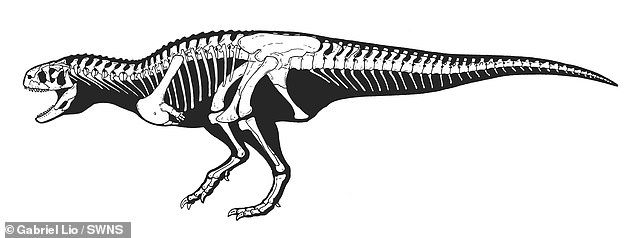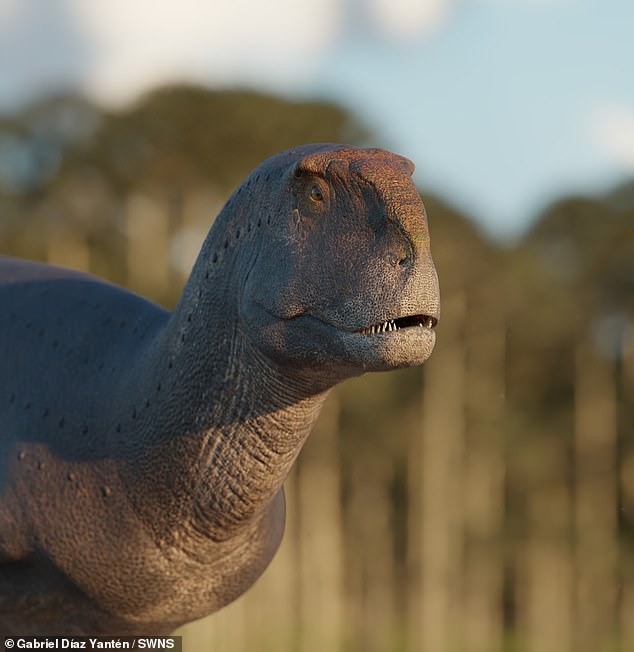Step aside, T.Rex! Newly Discovered Dinosaur That Roamed Patagonia for 70 Million Years Even Had SMALLER Arms Than the ‘King of the Dinosaurs’
If you thought T.Rex had short arms, wait until you see this newly discovered dinosaur.
A carnivorous species called Koleken inakayali roamed the Earth 70 million years ago and had even smaller forelimbs than the ‘King of the Dinosaurs’.
National Geographic explorer Diego Pol and a global team of researchers and paleontologists have discovered its fossilized remains in the La Colonia Formation in central Patagonia.
The name Koleken inakayali is derived from the language of the Tehuelche people of the region and refers to the claystone in which the animal was found and to the Tehuelche leader Inakayal.
The dinosaur represents only the second known of the abelisaurid dinosaur family to have lived in the La Colonia Formation at the end of the dinosaur age in the Late Cretaceous.
If you thought T.Rex had short arms, wait until you see this newly discovered dinosaur. A carnivorous species called Koleken inakayali roamed the Earth 70 million years ago and had even smaller forelimbs than the ‘King of the Dinosaurs’

A common feature of abelisaurid dinosaurs, such as Koleken inakayali or Tyrannosaurus rex (artist’s impression), are their short arms
Koleken resembles the iconic ‘beef bull’ Carnotaurus sastrei, the only other abelisaurid known from the La Colonia Formation, which was popularized in the film Jurassic World.
However, unlike Carnotaurus, Kotleken is smaller in size and exhibits a unique set of skull features and anatomical differences – most notably the absence of the enormous frontal horns that Carnotaurus possesses.
The team’s research, published in the journal Cladistics, describes their findings, which consist of a partial skeleton, including several skull bones, a nearly complete set of spines, a complete hip, several tailbones and nearly complete legs.

Koleken resembles the iconic ‘beef bull’ Carnotaurus sastrei, the only other abelisaurid known from the La Colonia Formation

The team’s research, published in the journal Cladistics, describes their findings, which consist of a partial skeleton, including several skull bones, a nearly complete set of spines, a complete hip, several tailbones and nearly complete legs.
“This finding sheds light on the diversity of abelisaurid theropods in Patagonia just before the mass extinction,” says Diego Pol.
‘Our study also analyzes the evolution of abelisaurids and their relatives through time, identifying pulses of accelerated skull evolution in the Early Cretaceous.
‘It extends our knowledge of abelisaurids that lived in this area during the Cretaceous and shows that they were more diverse than previously thought.’
A common feature of abelisaurid dinosaurs, such as Koleken inakayali or Tyrannosaurus rex, are their short arms.
Theories for this include their use for killing prey at close range, or they evolved to stay out of the way of the carnivore’s deadly bite.

A common feature of abelisaurid dinosaurs, such as Koleken inakayali or Tyrannosaurus rex, are their short arms
“The discovery of Koleken inakayali significantly advances our collective scientific understanding of the dinosaur age,” said Ian Miller, Chief Science and Innovation Officer of the National Geographic Society.
‘The addition of Koleken inakayali to the fauna of the La Colonia Formation continues to demonstrate that the formation is one of the most important dinosaur-bearing end-Cretaceous rock units in the world.
“Diego and his team of global experts, researchers and laboratory technicians bring new insights into this lost world to life and advance the work of the National Geographic Society to engage in science and research to better understand and transform the wonder of our world share findings with the world. global community.”
